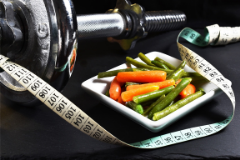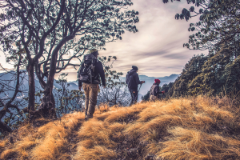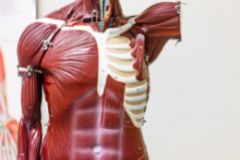PHYSICAL EDUCATION & HEALTH DOMAIN
Stacey Hockin
Physical Education & Health Instructional Leader
Health and Physical Education focuses on students enhancing their own and others’ health and wellbeing and physical activity participation. Research in fields such as sociology, physiology, nutrition, biomechanics and psychology informs what we understand about healthy, safe and active choices. Health and Physical Education offers you an experiential curriculum that is contemporary, relevant, challenging, enjoyable and physically active.
As a foundation for lifelong physical activity participation and enhanced performance, you develop proficiency in movement skills, physical activities and movement concepts, as well as acquire an understanding of the science behind how the body moves. In doing so, you develop an appreciation of the significance of physical activity, outdoor recreation and sport both in Australian society and globally.
Health and Human Development 1-2

- Identify major health inequalities among Australia’s youth
- Investigate the roles and sources of major nutrients
- Analyse changes in the transition from youth to adulthood
Subject Code: V1PHD
Year Level: 11
Unit 1: Understanding health and wellbeing
You consider the influence of age, culture, religion, gender and socioeconomic status on perceptions of and priorities relating to health and wellbeing. We look at measurable indicators of population health, and at data reflecting the health status of Australians. You investigate the roles and sources of major nutrients and the use of food selection models and other tools to promote healthy eating.
There is a focus on the health and wellbeing of Australia’s youth, and conduct independent research into a selected area of interest. You identify major health inequalities among Australia’s youth and reflect on the causes.
What does this mean for me?
You explain multiple dimensions of health and wellbeing used to evaluate the variations in health status of youth and identify key areas for improving youth health and wellbeing. You apply nutrition knowledge and tools to the selection of food and the evaluation of nutrition information.
Unit 2: Managing health and development
We investigate transitions in health and wellbeing, and development, from lifespan and societal perspectives. We look at changes and expectations that are part of the progression from youth to adulthood. This unit promotes the application of health literacy skills through an examination of adulthood as a time of increasing independence and responsibility, involving the establishment of long-term relationships, possible considerations of parenthood and management of health-related milestones and changes. You enquire into the Australian healthcare system and extend their capacity to access and analyse health information. Our class considers the challenges and opportunities presented by digital media and health technologies, and consider issues surrounding the use of health data and access to quality health care.
What does this mean for me?
You explain developmental changes in the transition from youth to adulthood. You describe how to access Australia’s health system and how it promotes health and wellbeing in their local community.
Assessment
- Course work
- Research assignments
- Outcome tests
- End of semester exam
What sort of student would like Health & Human Development?
Someone who:
- Has an interest in how humans change over their lifespan and wants to explore the varying factors that influence our health and development and that of different people
- Wants to learn more about what is being done globally to improve the health of the human race
- Is interested in health promotion and world issues.
Pre-requisites:
Nil. However, completing any Pathways PE/Health subject can be useful.
Outdoor and Environmental Studies 1-2

- Understand the impact human lifestyles have on outdoor environments
- Develop practical skills to help you live sustainably
- Gain firsthand experience on a number of outdoor excursions
Subject Code: V1POE
Year Level: 11
Unit 1: Connections with outdoor environments
Our class examines some of the ways in which indigenous and non indigenous Australian's understand and relate to nature through experiences. We focus on individuals and their personal responses to, and experiences of, the outdoors. You develop practical skills and knowledge to help you live sustainably. There is a variety of learning experiences aimed at allowing you to learn in the field as well as the classroom.
Two multi-day field trips are planned.
Unit 2: Discovering outdoor environments
We study nature’s impact on humans, as well as the ecological, social and economic implications of human impact. You develop a clear understanding of the impact of technologies and changing human lifestyles on outdoor environments. We examine a number of case studies, including areas where there is evidence of human intervention. You develop the practical skills required to minimise human impact on outdoor environments.
Planning, participating and peer leading learning activities include gaining first-hand experience of a number of different local ecosystems.
One multi-day trip and a number of single day or part day trips are planned.
Assessment
- Course work
- Research assignments
- Field trip planning, and leading reports and journals
- Outcome tests and SACs
- End of semester exam
What sort of student would like Outdoor & Environmental Studies?
Someone who:
- Is interested in outdoor activities
- Has a desire to learn from practical experiences
- Has an awareness of environmental issues
- Likes to contribute to improvements in the outdoor environments we visit
- Can work independently and use information from a number of sources to complete learning tasks.
Pre-requisites
Nil. However, students are strongly encouraged to have completed Outdoor Education in Pathways (9-10).
Other Considerations
*This subject incurs additional costs.
Physical Education 1-2

- Explore how the musculoskeletal and cardiorespiratory systems work together
- consider a variety of legal and illegal practices and substances used to enhance performance
- Investigate the possible causes of illness and injury
Subject Code: V1PPE
Year Level: 11
Unit 1: The human body in motion
We explore how the musculoskeletal and cardiorespiratory systems work together to produce movement. You investigate the role and function of the main structures in each system and how they respond to physical activity, sport and exercise.
Using a contemporary approach, we evaluate the social, cultural and environmental influences on movement. We consider the implications of the use of legal and illegal practices to improve the performance of the musculoskeletal and cardiorespiratory systems, evaluating perceived benefits and describing potential harms. You also recommend and implement strategies to minimise the risk of illness or injury to each system.
What does this mean for me?
You participate in a variety of practical activities to explain how the musculoskeletal, respiratory & cardiovascular system works. You evaluate the ethical and performance implications of the use of practices and substances that enhance human movement.
Unit 2: Physical activity, sport & society
We develop your understanding of physical activity, sport and society from a participatory perspective. You are introduced to types of physical activity and the role participation in physical activity and sedentary behaviour plays in your own health and wellbeing as well as in other people’s lives in different population groups.
You collect data to determine perceived enablers of and barriers to physical activity and the ways in which opportunities for participation in physical activity can be extended in various communities, social, cultural and environmental contexts.
We investigate individual and population-based consequences of physical inactivity and sedentary behaviour. You study and apply the social-ecological model and/or the Youth Physical Activity Promotion Model to critique a range of individual and settings-based strategies that are effective in promoting participation in some form of regular physical activity.
What does this mean for me?
You collect and analyse data related to individual and population levels of participation in physical activity and sedentary behaviour. You apply a social-ecological framework to research, analyse and evaluate a contemporary issue associated with participation in physical activity and/or sport in a local, national or global setting.
Assessment
- Course work
- Research assignments
- End of year exam
What sort of student would like Physical Education?
Someone who:
- Is active and enjoys physical activity
- Wants to learn about the body systems
- Has an interest in factors that influence physical activity
- Wishes to develop and undertake a training program.
Pre-requisites
Nil. However, a Pathways subject such as PE/Health, Health & Human Development, Human Movement & Performance or Physical Education (Boys or Girls) can be useful.
